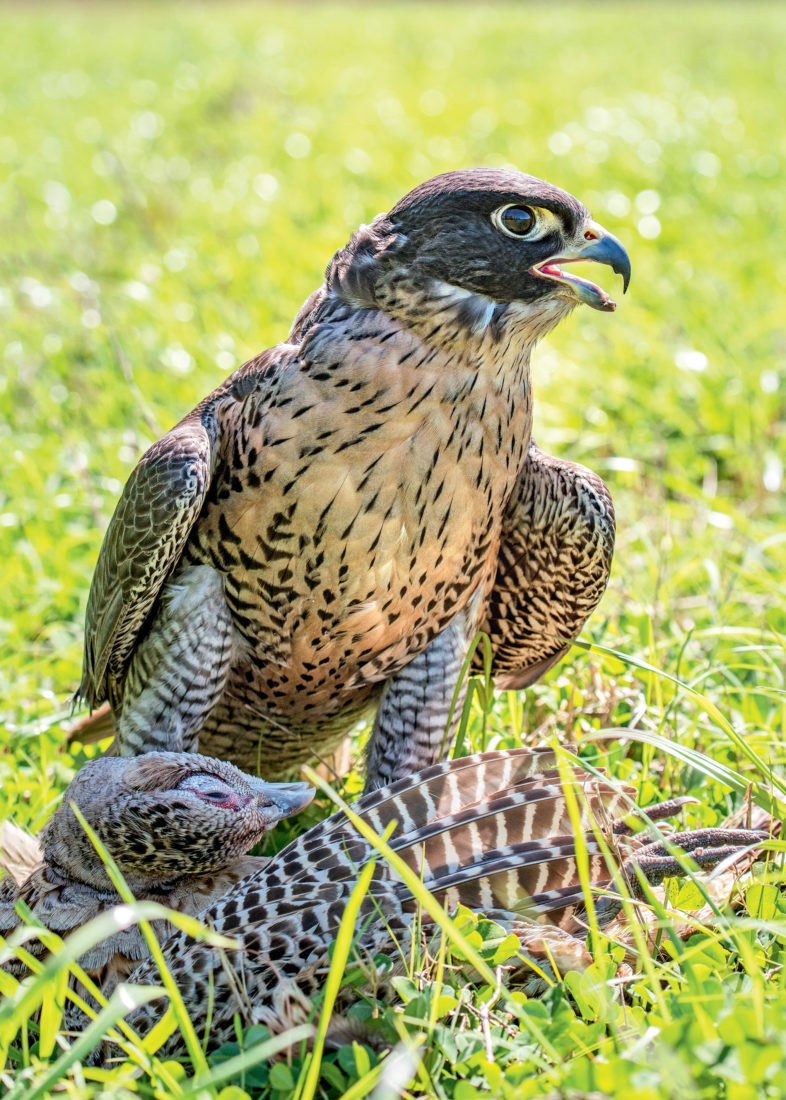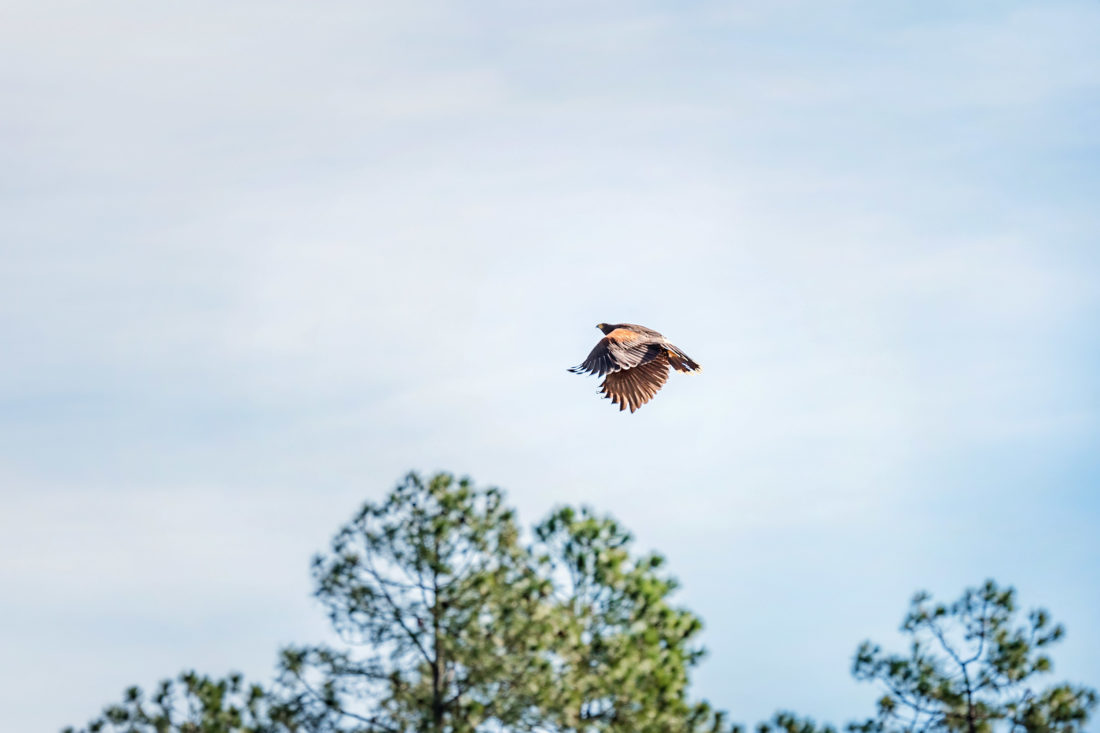It is a hunt with no weapons, a sport with no players. A pursuit equal parts patience, precision, and raw power. And we are waiting for it to start in a patch of quiet quail woods along the Georgia coast. Welcome to a falcon hunt at Sea Island’s Broadfield sporting club—one of the only resorts in the country offering the pastime.
With hunting dogs frozen on point, a quail shoots out of a cluster of bushes. Almost instantly, Einstein, a mahogany-colored Harris’s hawk, swoops down to intercept the bird. At once both are on the ground—the quail motionless, Einstein guarding his catch—until Chris Kennedy, a quail guide and master falconer at Broadfield, moves in to call the hawk off. Handing a thick brown leather falconer’s glove to me, Kennedy whistles for Einstein, who with a pump of his wings flies up and lands gently on my outstretched wrist, no heavier than a friend’s hand. The hawk looks me in the eye and, after a beat, he is gone, following the dogs.
Majestic as the scene is, the story of how falconry, the ancient “sport of kings,” came to Sea Island begins with a slightly less regal group: dozens of aggressive boat-tailed grackles, scavenger birds that were swiping french fries from the resort’s youngest pool guests—and giving management heartburn in the process. Looking for a solution, Sea Island turned to Steve Hein, a master falconer and the executive director of Georgia Southern University’s Center for Wildlife Education and the Lamar Q Ball, Jr. Raptor Center. Hein had a long-standing relationship with the resort and was also a mentor to fellow falconer Jon Kent, Sea Island’s director of outdoor pursuits. In 2011, Hein began the Raptor Patrol, which kept the birds at bay by stationing Harris’s hawks and peregrine falcons near the beach club’s pool under the control of a licensed falconer.

Photo: michael hrizuk
Cobra, a gyrfalcon-peregrine hybrid, lands a hen pheasant.
A year later, Sea Island acquired nearby Broadfield, a historic hunting property, to use as a sporting club for guests, and Kent saw an opportunity to bring the raptors into their programming. While other resorts were offering falcon handling or falconry schools, he and Hein wanted to do more. “We worked with Sea Island to say, how can we bring an experience that eclipses anything else that’s being done?” Hein says.
So Hein helped create an actual hunt—one that would take guests across Broadfield’s 5,800 acres to practice the falconry that he and Kent loved, during a season that lasts from mid-October through March. True to the sport’s origins before the days of gunpowder, when aristocrats trained birds of prey to hunt small game, no firearms would be involved. Hawks and falcons would hunt the prey—three types of game across three different areas of raw terrain—while a team of Broadfield falconers, guests, and a few bird dogs would do everything else.
Watch: Apprentice falconer Paige Hansen shows off Grace, a Harris’s hawk
A day of falconry starts on the bird buggy, a Toyota Tundra with the roof cut off, rambling away from Broadfield’s nine-room lodge through columns of moss-draped live oaks. The group is led by Kennedy, a thirty-one-year-old who learned the sport from his father while growing up in Marietta, Georgia, and Paige Hansen, a twenty-three-year-old apprentice falconer whose fondness for animals led her to a zoo internship that included birds of prey, and later a falconry apprenticeship with Jon Kent. After hunting quail with Einstein, we move into Broadfield’s dense hardwood forest to track squirrels with two female Harris’s hawks, whose smaller feet are better suited to catching the fast-moving rodents. Finally, the buggy takes us to a wind-whipped field where Cobra, a gyrfalcon-peregrine hybrid, will hunt pheasant released by Broadfield.

Photo: michael hrizuk
Apprentice falconer Paige Hansen, on the beach, at Georgia’s Sea Island with Grace.
Between kills, Kennedy and Hansen talk to the birds, coaxing them on, doting on them like parents on a favorite child. Like most master falconers, Kennedy keeps many of the Broadfield birds on his own property, with mews and weathering yards designed specifically for the raptors. He and his team monitor the birds’ feathers, meals, and weight to the gram. They delight in their personalities and mood swings and snap pictures to save on their iPhones. “I love to get a front-row seat to watch them work,” Hansen says.
The final hunt ends as quickly as it begins. Spotting a pheasant, Cobra tucks his wings and “drops like a teardrop out of the sky,” in Kennedy’s words. As the fastest animals on earth, peregrine falcons can reach speeds of 240 miles per hour to dispatch their prey. The two birds disappear together into the tall grass. Only Cobra emerges, to perch on Kennedy’s gloved arm.
We head back to the Broadfield lodge with several quail, no squirrels, and one large pheasant. But as Steve Hein says, “It’s a lot like fly fishing—it’s not about what you catch, it’s about everything in between. And that’s why we consider it not just a sport, but an art form.”

Photo: michael hrizuk
Einstein, a Harris’s hawk, in flight.








